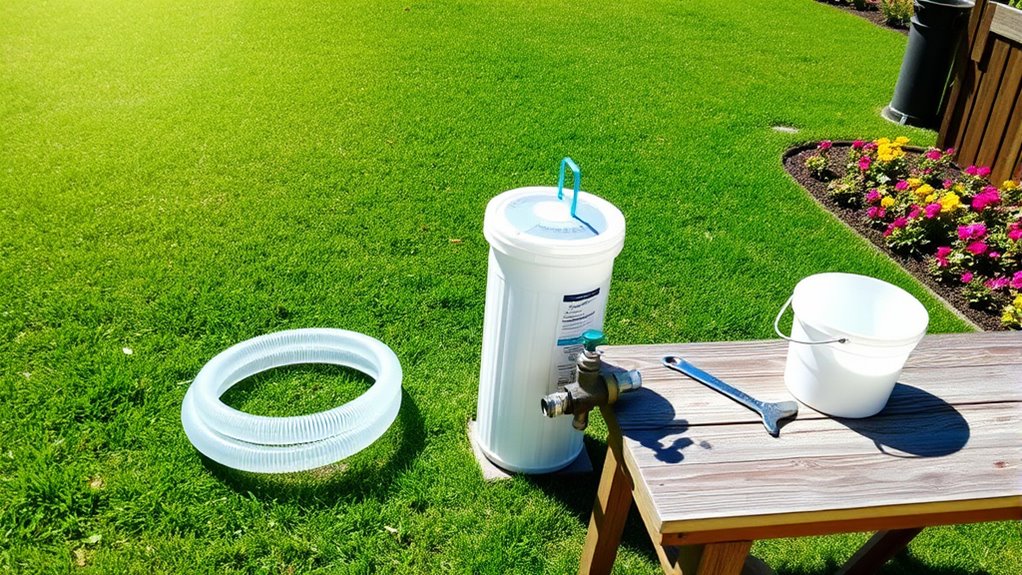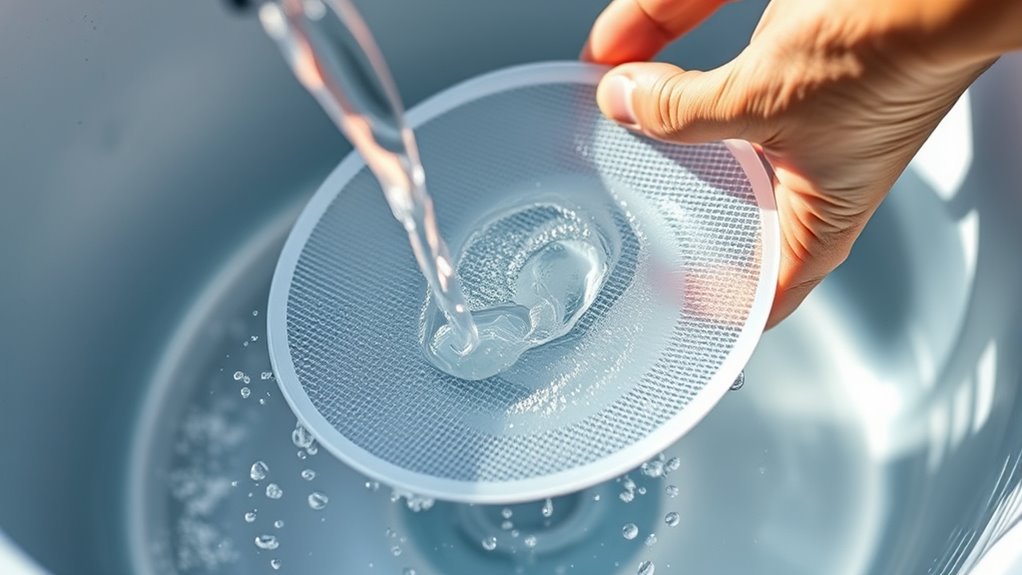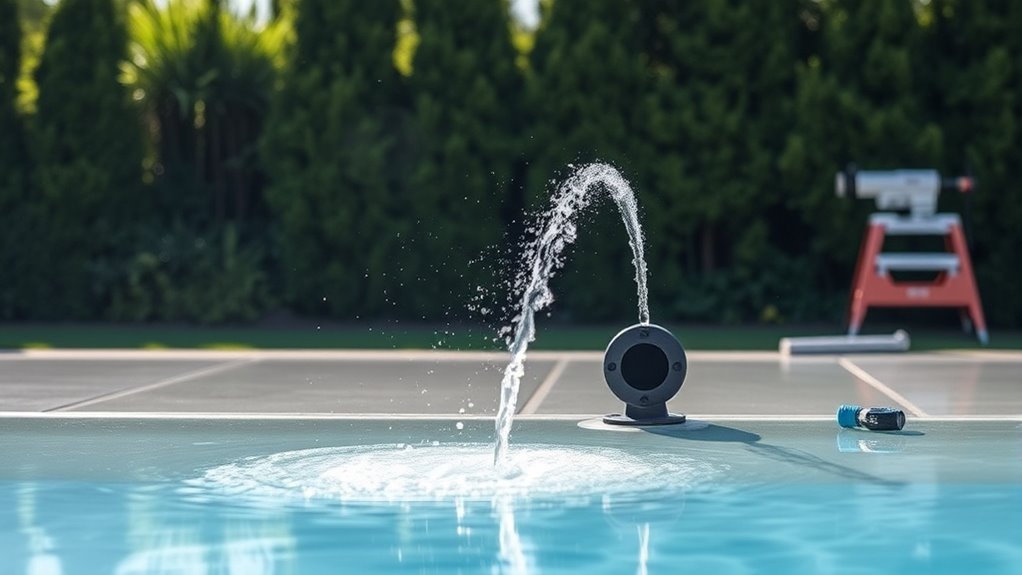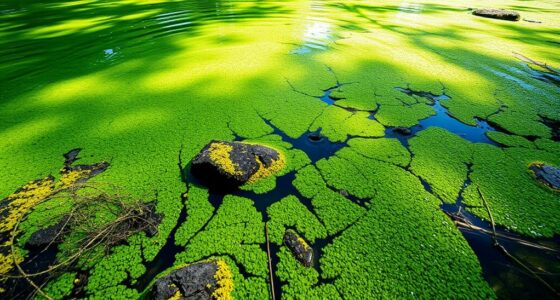To backwash your DE filter without a mess, start by gathering supplies like a debris container, gloves, and a backwash hose, then turn off your pool pump and set the diverter valve to “Backwash” carefully. Use gentle water flow and keep the outlet directed away from your area, monitoring for leaks and splashes. After flushing out debris, turn everything off, reset your system, and you’ll keep the process clean—learn more for a smooth, mess-free cleanup.
Key Takeaways
- Set the filter valve to “Backwash” and ensure all connections are secure before starting.
- Use a debris container and towels or tarps to catch splashes and prevent spills.
- Control water flow with nozzles designed for gentle flushing, avoiding turbulence and splashes.
- Regularly monitor outlets and connections for leaks or blockages throughout the process.
- Carefully close the drain valve, turn off the pump, and reset system components to prevent residual mess.
Gather Your Supplies and Prepare the Area

Before you begin backwashing the filter, gather all necessary supplies and prepare the work area. You’ll need a backwash hose, a bucket or container for debris, and possibly gloves and safety goggles. Make sure you have a garden hose connected to your water supply if needed. Clear the area around the pool and filter to prevent tripping hazards and spills. Check that your backwash valve is accessible and that you have enough space to move comfortably. It’s helpful to lay down towels or a tarp to catch any splashes or debris. Having everything ready guarantees the process goes smoothly, minimizes mess, and saves you time. Preparing in advance keeps the task safe, efficient, and less stressful. Proper planning also involves understanding the filter’s backwashing process, which can help prevent mishaps during the task.
Turn Off the Pool Pump and Set the Valve Correctly

To guarantee a safe and effective backwashing process, you need to turn off your pool pump first. This prevents water flow during valve adjustments, avoiding damage or spills. Next, locate your multi-port valve or diverter valve on the filter. Set the valve to the “Backwash” position to direct water flow toward the waste line, bypassing the filter. If your valve has a “Waste” option, use that setting. Ensure the valve is securely in place to prevent leaks. Turning off the pump and correctly setting the valve helps isolate the filter system, making the backwashing process cleaner and safer. Confirm the valve is firmly positioned before proceeding to the next step, ensuring no accidental water flow in the wrong direction.
Remove the Pool Pump Lid and Prepare for Backwashing

Have you removed the pool pump lid yet? If not, put on gloves to protect your hands from dirt and debris. Carefully unscrew the lid, turning it counterclockwise, and set it aside in a clean area. Check inside the pump for any debris or blockages and remove them if necessary. Once the lid is off, prepare your backwash hose or outlet to direct dirty water away from your pool area. Make sure your equipment is ready and the area around the pump is clear. Removing the lid allows access to the filter and ensures a smooth backwashing process. Take your time, keep everything organized, and double-check that all connections are secure before proceeding. Proper shower maintenance can help extend the lifespan of your pool filtration system and prevent common issues during backwashing.
Initiate the Backwash Process Carefully

Once everything is in place, you can begin the backwashing process by turning the filter valve to the backwash setting. Do this slowly to prevent sudden pressure changes that could damage the system. As you turn the valve, listen for any hissing sounds that indicate a proper seal. Keep a close eye on the pressure gauge; when it drops to the normal operating range, you’re ready to start the flow. Turn on the pump and let it run for about two minutes. Watch for debris and dislodged dirt to start flowing out of the waste line. Don’t rush this step—taking your time ensures you clear out the buildup without risking water spillage or system damage. Regular filter maintenance helps prolong the system’s lifespan and ensures optimal performance. Once you’re confident, move on to the next phase of backwashing.
Minimize Splashing During the Flushing Stage

To reduce splashing during the flushing stage, make sure you’re using the proper nozzles designed for gentle water flow. Adjust the flow rate so it’s not too high, which can cause unnecessary splashing and water loss. These simple steps help keep the process efficient and minimize mess. Additionally, incorporating protective styling benefits can help safeguard the equipment and surrounding area from water damage during operation.
Use Proper Nozzles
Using proper nozzles is vital to minimize splashing during the flushing stage of filter backwashing. The right nozzles direct water flow smoothly, reducing turbulence and mess. First, choose nozzles with adjustable spray patterns; narrow jets focus water precisely where needed. Second, guarantee nozzles are compatible with your backwash system to prevent leaks or uneven flow. Third, position nozzles at ideal angles—usually downward—to control splash and direct debris away from equipment. Fourth, regularly inspect and clean nozzles to keep spray consistent and prevent clogging, which can cause unpredictable splashing. By selecting and maintaining the correct nozzles, you keep backwashing efficient and mess-free, ensuring your filter system stays clean and operational. Proper nozzles are a vital step in a smooth, clean backwashing process.
Adjust Flow Rate
Adjusting the flow rate during backwashing is essential for minimizing splashing and ensuring a smooth flushing process. If the flow is too high, water will splash out, creating a mess and wasting water. To avoid this, start with a gentle flow and gradually increase it until the water moves briskly through the filter without splashing. Keep a close eye on the water’s movement; it should be steady and controlled. If you notice splashing or turbulence, dial back the flow slightly. Using a valve or flow control device helps maintain consistent pressure. Properly adjusting the flow rate helps prevent water loss, keeps your area clean, and guarantees the filter is thoroughly cleaned without unnecessary mess. Incorporating flow regulation techniques ensures a more efficient backwashing process and prolongs the lifespan of your filter.
Monitor the Backwash Outlet and Prevent Spills

You should regularly check the backwash outlet to catch any signs of leaks or blockages early. Using spill containment measures can help prevent water from escaping and causing damage. Staying vigilant guarantees a smooth backwashing process and avoids costly spills.
Check Outlet Regularly
How often do you check the backwash outlet during the filtration process? Regular monitoring prevents spills and keeps the backwashing smooth. You should:
- Observe the outlet every 10-15 minutes to catch any sudden leaks or clogs early.
- Look for signs of overflowing or slow drainage, which indicate blockages or pressure issues.
- Ensure the outlet remains unobstructed and free of debris that could cause backups.
- Adjust flow rates if you notice water pooling or spilling to avoid messes.
- Understanding the role of contrast ratio in image quality can help you better maintain system performance and troubleshoot issues effectively.
Consistent checks help you catch problems before they escalate. Keeping an eye on the outlet minimizes spills and maintains a clean process. Routine monitoring is essential for efficient, mess-free backwashing.
Use Spill Containment
To prevent messy spills during backwashing, implementing spill containment measures is essential. You should position spill containment trays or berms beneath the backwash outlet to catch any leaks or excess water. Make sure the containment area is large enough to hold all discharge, preventing water from spreading onto the ground or surrounding surfaces. Regularly monitor the outlet during backwashing to catch any signs of overflow or leaks early. Use proper hoses and fittings to secure connections, reducing the risk of accidental spills. If you notice any leaks, address them immediately before continuing. Additionally, understanding the power output of electric dirt bikes can help determine the appropriate safety measures for high-speed models. By actively supervising the outlet and maintaining containment measures, you keep the area clean and safe, avoiding messes and potential hazards caused by spilled water.
Finish Up and Return the Filter to Normal Operation

Once the backwashing process is complete, carefully close the drain valve and turn off the backwash pump. Next, follow these steps to return your filter to normal operation:
- Reset any control valves to their original positions to resume regular flow.
- Turn the main pump back on, ensuring water flows smoothly through the filter.
- Check for leaks or drips around connections and fittings.
- Monitor pressure gauges to confirm they stabilize within normal ranges.
- Confirm that the system is operating with proper efficiency, ensuring environmental and operational safety.
Ensure the filter is clean and free of debris before resuming full operation. Run the system for a few minutes to verify proper function. Finally, clean up any spilled water and dispose of waste filters appropriately. Your system should now operate efficiently without mess.
Frequently Asked Questions
How Often Should I Backwash My DE Filter?
You should backwash your DE filter about every 4 to 6 weeks, or whenever you notice reduced water flow or clarity issues. Regular maintenance helps keep your filter working efficiently. Keep a close eye on your pool’s condition, especially during peak swimming months. When you backwash, do it carefully to prevent messes—use a proper drain connection and clear the area beforehand. This way, you’ll maintain a clean and healthy pool.
Can I Backwash Without Turning off the Pump?
You shouldn’t backwash your DE filter without turning off the pump. Doing so can cause debris and dirty water to escape, creating a mess. Before you start, shut off the pump and release pressure from the system. This guarantees a clean, safe backwash process. Once you finish, turn the pump back on slowly to prevent any damage. Always follow these steps for a mess-free, effective cleaning.
What Signs Indicate My DE Filter Needs Backwashing?
You’ll notice your DE filter needs backwashing when your pool’s flow rate drops, the water becomes cloudy, or the pressure gauge shows a significant increase—typically 8-10 psi above normal. If you see these signs, it’s time to backwash your filter. Regularly monitoring your pressure gauge helps catch issues early, ensuring your pool stays clean and clear without unnecessary mess or damage.
Is It Necessary to Replace the DE Powder After Backwashing?
Yes, you should replace the DE powder after backwashing. During the process, some of the DE gets washed away, reducing the filter’s effectiveness. Once you finish backwashing, add a fresh layer of DE to restore proper filtration. Make sure to follow the manufacturer’s recommended amount to avoid over- or under-filling, which can cause issues like channeling or poor water clarity.
How Do I Prevent Debris From Entering the Pool During Backwash?
You can prevent debris from entering your pool during backwashing by keeping the multiport valve in the rinse position and ensuring all valves are securely closed before starting. It’s a coincidence that a quick check of your pool’s skimmer and pump basket can also catch debris early. Always monitor the process closely and turn off the pump immediately if you notice debris escaping, keeping your pool clean and mess-free.
Conclusion
Remember, a clean filter keeps your pool sparkling, but rushing can cause a mess. Take your time with each step, stay attentive, and you’ll backwash like a pro. As the saying goes, “A stitch in time saves nine.” By following these tips carefully, you’ll avoid spills and guarantee your pool stays pristine. Patience and preparation are key—soon enough, you’ll enjoy crystal-clear water without the cleanup hassle.









